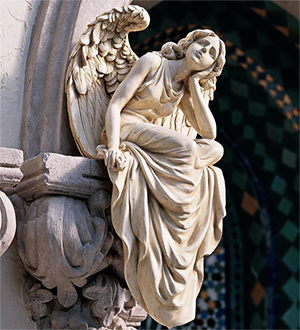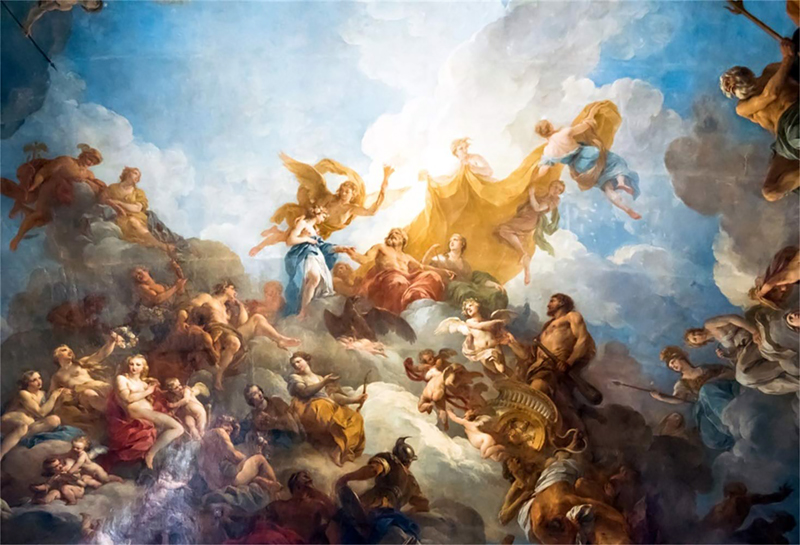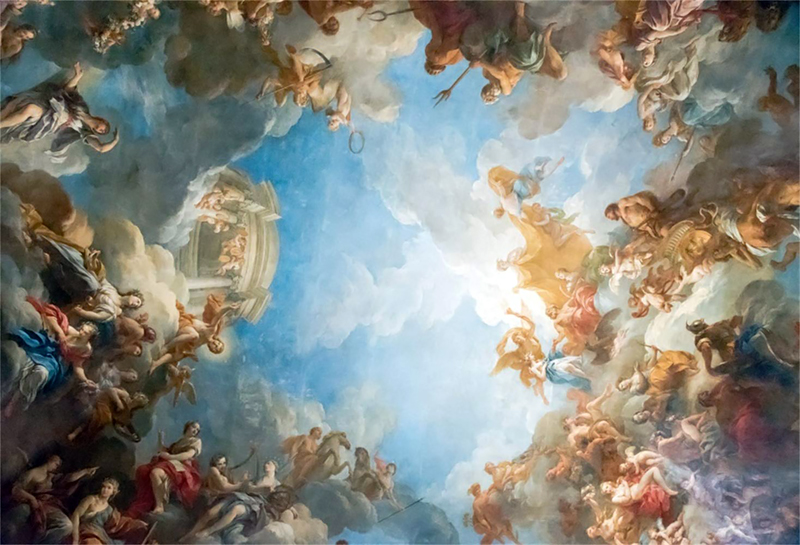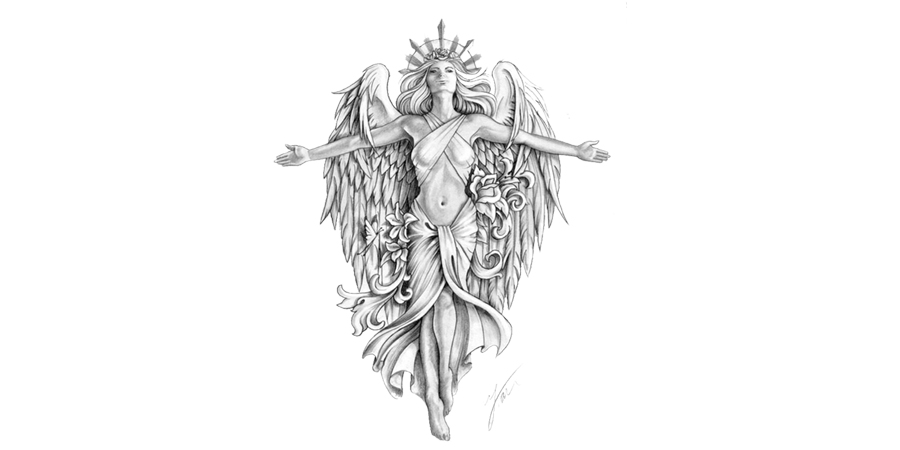Angels: (from the Latin Angelus meaning messenger) are a race of spiritual beings intermediate between God and men; described in Hebrew, Christian, and Islamic scriptures, as well as in the Kabala. They are usually depicted with wings (but not always) and have no gender unless granted physical form in a mission to the Earthly realm.
 In religions based on revelation, God and humans are distant from each other, Angels help bridge the gap. Angels praise God, carry out God’s will, and reveal divine word. They may also help people attain salvation or receive special favors. Furthermore, acting for God, angels may influence human affairs through such deeds as rewarding faithful believers, punishing people who do evil, and helping people in need.
In religions based on revelation, God and humans are distant from each other, Angels help bridge the gap. Angels praise God, carry out God’s will, and reveal divine word. They may also help people attain salvation or receive special favors. Furthermore, acting for God, angels may influence human affairs through such deeds as rewarding faithful believers, punishing people who do evil, and helping people in need.
Angels tend to play a lesser role in religions with many gods. The gods themselves may carry out angelic functions, often taking human forms. In religions based on the belief that all the cosmos is sacred and that the divine and the human share one essence, angels are less important. They are not needed to bridge a gap between the gods and humankind. However, even in these religions angel-like spiritual beings may help people relate to the divine.
The Nature of Angels
The world’s religions have had different views about the nature of angels. Some regard angels as divine beings who deserve to be worshiped rather than just as messengers of God. Disagreement also exists about the bodies of angels. Some think that angels have actual physical bodies. Others insist that angels only appear to have such bodies. Still others believe that angels are purely spiritual beings but that they can assume material bodies.
Zoroastrianism and Judaism
The view of angels in Judaism was influenced by Zoroastrianism. Zoroastrian mythology describes a cosmic clash between Ahura Mazda and Ahriman—forces of good and evil with their armies of angels and devils. Like Ahura Mazda, the Old Testament god Yahweh has an army of angels. These warrior angels battle against evil forces led by Satan, who resembles Ahriman.
Following the Zoroastrian view, Judaism divides the universe into three parts: earth, heaven, and hell. Earth is the home of humans. Heaven is reserved for God and his angels. Hell is the dark world of Satan and his followers. Angels fulfill a similar role in the two religions, linking heaven with the world of humans and revealing God’s plans and laws. Their function is to serve God and carry out his will. They reward goodness and punish wickedness and injustice. They also help people understand God’s will, and they take the souls of righteous individuals to heaven.

Christianity
The Christian concept of a three-part universe came from Judaic and Zoroastrian ideas, as did Christian ideas of angels and their functions. In the Christian view, angels are God’s messengers. Angels proclaimed the birth of Christ and continue to play an active role in the daily lives of Christians. They bring strength to those who are weak and comfort to those who suffer and carry the prayers of faithful Christians to God. According to legends, guardian angels watch over children.
Islam
The Islamic idea of angels is similar to Judaic and Christian views. God is in heaven, and the angels serve him and carry out his will. However, while Judaism and Christianity generally divide spiritual beings into those who are with or against God, Islam divides such beings into angels, demons, and djinni, or genies. The djinni may be either good or harmful. According to Islamic folklore, they were created out of fire, can be visible or invisible, and can assume various human or animal shapes.
Angels endowed with divine knowledge appear in the apocalyptic and rabbinic literature as the teachers of men. This is the so-called “whisper of the angels”. Michael initiated Adam and Seth into the secrets of creation and taught Adam agriculture. The angels Michael, Uriel, and Raziel initiated Enoch into the mysteries of the world. The angels mediate between God and man and carry the prayers up to the throne of God. Angels accompany the dead on their departure from this world.
Influences
How far this Angelology was influenced by Babylonian and Persian mythology, and what its relations are to Mandæan lore and to Egyptian-Hellenistic Gnosticism, is still a matter of dispute but Persian mythology is throughout and interwoven with Angelology (see Brandt, “Mandäische Religion,” pp. 194-198).
Coptic Gnosticism, also, has Ariel as king of the nether world, corresponding with Ur of the Mandæans. Over thousands of years, mankind has described the functions of angels in many ways. The role of angels is developed in greatest detail in religions based on revelation – the disclosure or communication of divine truth or divine will to human beings. These monotheistic religions that share this view include Judaism, Christianity, Islam, and Zoroastrianism. In the Koran, Jewish and Gnostic angelologies seem to be intermingled. In Mohammed’s time the old Arabian goddesses—Al-Lat, Al-Uzza, and Manat —were spoken of as angels and daughters of God (Koran, sura xxxvii. v.150, liii. v.20). The chief of all the archangels is Gabriel (Jibril); Michael comes next; Israfil (Sarafiel) sounds the trumpet of the resurrection; and Azrael is the angel of death (the etymology of the last name is obscure). Instead of four, there are eight angels that support the throne of God (sura xlix. v.17). Some angels have two, some three, others four wings (sura xxxv. v.2). “They celebrate the praise of their Lord and ask forgiveness for those that are on earth” (sura xlii. v.2).

The Creation of Angels
Angels accompany the dead on their departure from this world. Accompanying angels are not permanent, but temporary, companions, they carry out missions but can be constantly re-dispatched by the least of us through faithful prayer as answered by the almighty. No single angel can carry out two messages, nor can two angels fulfill only one message. Of the three angels that came to Abraham, Michael, the guardian angel of Israel, brought the tidings of Isaac’s birth; Gabriel, the angel of heavenly vengeance and of fire, had to overthrow Sodom; and Raphael rescued Lot” (Gen. xviii. v.2). Michael to the right, Uriel to the left, Gabriel in front, and Raphael in the rear of the throne. The Book of Jubilees, a version of the Pentateuch speaks of the Creation of Angels: “The angels of the face and of glorification, the angels of the elements of fire, wind, and darkness, of hail and hoar frost, thunder and lightning, of cold and heat, of winter and spring, summer and fall, of the abyss and night, of light and morning, were created on the first day. “Since Medieval times Christian theology has taught that Angels are organized into several orders, or Angelic Choirs.
Representation of Angels
At first, artists struggled with the problem of how to represent angels. Written descriptions were not very helpful. They tended to be vague or bizarre or did not draw a clear distinction between angels and human beings.
Artists tried various approaches before arriving at the image of a young male figure. Later they added two feathery wings to the figure. The wings suggested that angels were spiritual beings elevated above humans and associated with heaven. Besides wings, angels were sometimes shown with halos, long hair, and flowing white robes.
The idea of representing spirits as winged figures dates back many thousands of years. The ancient Egyptians portrayed the sun god Horus as a winged disk. Other winged beings can be found in ancient Greek and Roman art.
- Special thanks to all the sources for this article: howarddavidjohnson.com & mythencyclopedia.com

